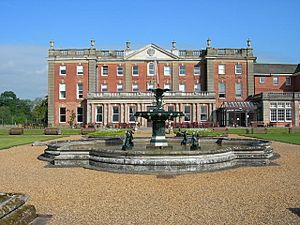Newbold Revel facts for kids
Newbold Revel is an old country house and a historic piece of land in North East Warwickshire, England. It's been around since the 1700s! A long time ago, in the 1400s, a famous writer named Sir Thomas Malory lived on this estate. Today, the house is used as a training college for the HM Prison Service. It's also a special building, listed as Grade II*, which means it's important and protected.
Historically, Newbold Revel was part of a bigger area called Monks Kirby. Now, it's in the modern area of Stretton-under-Fosse, near the town of Rugby.
The house you see today was built in 1716 for a person named Sir Fulwar Skipwith, 2nd Baronet. It's made of brick and has three floors. It's shaped like an "H" and has many windows across the front. Later, in the late 1800s, the ground floor was made a bit bigger.
Contents
A Look Back: The History of Newbold Revel
Newbold Revel has a long and interesting past, stretching all the way back to Anglo-Saxon times.
Early Days and Names
The estate is first mentioned in a very old book from 1086 called the Domesday Book. Back then, it was called Feniniwebold or Fenny Newbold. The word "Bold" is an old Anglo-Saxon word for "house." So, the name means "a new house or building."
The "Fenny" part meant it was on marshy, wet land. This helped people tell it apart from other places called Newbold in Warwickshire. Later, in the 1200s and 1300s, it was sometimes called Newbold (juxta) Stretton. By the early 1500s, it became known as Newnham Revell, named after the Revel family who owned it.
The Revel Family and Sir Thomas Malory
The Revel family took ownership of the manor around 1235. It stayed in their family for many years. Eventually, it passed down to Sir John Revel. When he died without a son, his daughter Alice inherited it. Alice married a man named John Malory.
Their son was Sir Thomas Malory, who is thought to be the author of the famous book Le Morte d'Arthur. This book tells the stories of King Arthur and the Knights of the Round Table. Sir Thomas Malory also served as a Member of Parliament for Warwickshire from 1443 to about 1446.
Later, Sir Thomas Malory's great-grandson, Nicholas, sold the property. After that, Newbold Revel was owned by several different people over the years. One of these owners was Sir Fulwar Skipwith, who built the current house in 1716.
Changing Hands and New Uses
In 1863, Edward Wood bought the estate. It stayed in his family for a while. Then, in 1898, it was bought by Colonel Heath, who made bricks. In 1911, a kind banker named Leo Bernard William Bonn bought it. He started a charity that later became the RNID, which helps people with hearing loss.
After Mr. Bonn passed away in 1929, his son, Major Walter Basil Louis Bonn, inherited the property. In 1931, Major Walter Bonn sold Newbold Revel to the Seventh-day Adventists. They used it as a college to train missionaries.
Newbold Revel During World War II
During World War II, in 1942, the government took over Newbold Revel. It was used as a secret training place for agents. It also became an RAF Y-station, which was a base for the Secret Intelligence Service. Here, they listened to German telephone communications.
After the War
After the war ended, the Sisters of Charity of St. Paul bought Newbold Revel. They used it as a college to train Catholic teachers. Then, in 1978, they sold it to British Telecom.
Finally, in 1985, the Prison Service took over Newbold Revel. They have been using it ever since as the Prison Service College, where they train staff for prisons.


